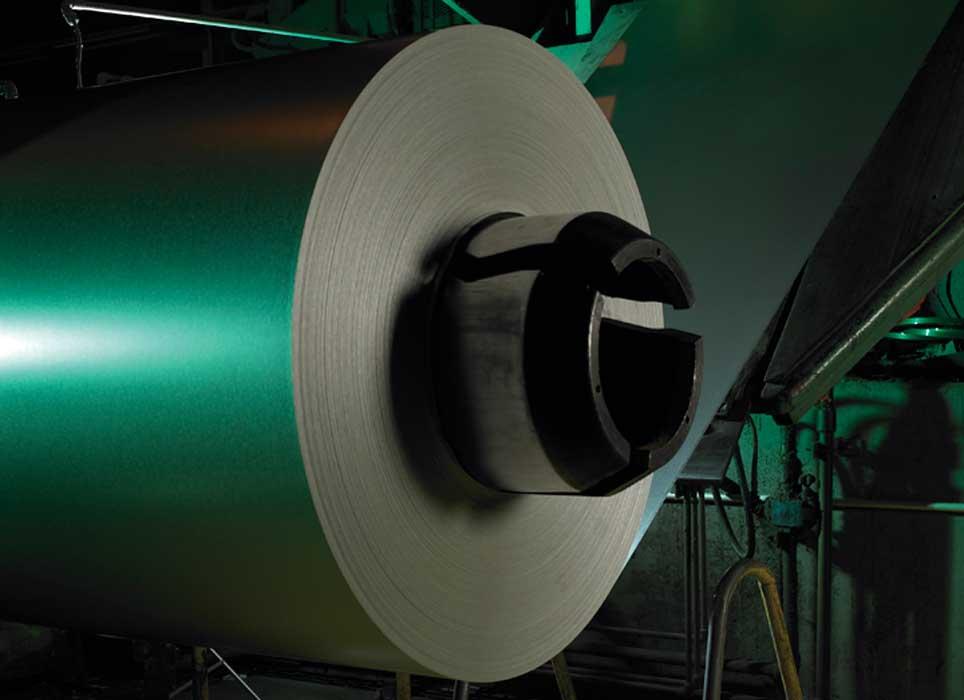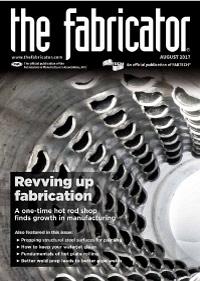- FMA
- The Fabricator
- FABTECH
- Canadian Metalworking
Categories
- Additive Manufacturing
- Aluminum Welding
- Arc Welding
- Assembly and Joining
- Automation and Robotics
- Bending and Forming
- Consumables
- Cutting and Weld Prep
- Electric Vehicles
- En Español
- Finishing
- Hydroforming
- Laser Cutting
- Laser Welding
- Machining
- Manufacturing Software
- Materials Handling
- Metals/Materials
- Oxyfuel Cutting
- Plasma Cutting
- Power Tools
- Punching and Other Holemaking
- Roll Forming
- Safety
- Sawing
- Shearing
- Shop Management
- Testing and Measuring
- Tube and Pipe Fabrication
- Tube and Pipe Production
- Waterjet Cutting
Industry Directory
Webcasts
Podcasts
FAB 40
Advertise
Subscribe
Account Login
Search
4 reasons that coil lines are not just for painting
Certain material treatment at the coil stage alleviates some production headaches for manufacturers
- August 14, 2017
- Article
- Metals/Materials

Figure 1
If certain coating operations can take place during the coil stage before the coils are delivered to a manufacturer’s facility, the company doesn’t have to worry about the production and environmental responsibilities that go along with those operations.
Manufacturers have long benefited from the speed, precision, and nonpolluting aspects of using coil lines to make prepainted metal panels. However, some manufacturers are unaware that many companies are using these lines to impart different characteristics on the metal coils (see Figure 1). This could include pretreatment or simply giving the surface a better-looking finish.
Here are four ways manufacturers can benefit from using coil lines (see Figure 2) as an effective first-step operation beyond prepainting.
No. 1: Coil Coating Means Better Material Handling
When it comes to stamping metal parts, manufacturers wrestle with a lot of issues dealing with the use of lubricants and oil. Perhaps the biggest issue is safety.
During application, oil often drips onto the floor, which can be dangerous for employees walking or operating a forklift. In some cases, using oil can impede the manufacturer’s goal of greater productivity. For example, companies fabricating parts in the past have applied so much oil that it made it impossible for robotic equipment to grip the steel because the metal surface was too slick to grasp. By switching to a dry film lubricant (DFL), a material that when in a solid phase is able to reduce the friction between two opposing surfaces, the companies can increase productivity and keep plants clean.
A customer of Chemcoaters Inc., Gary, Ind., discovered unexpected cost savings from using a dry film lubricant, which was applied at the coil stage to pretreat the metal. When handling the steel that used to be pretreated with oil, workers’ gloves became saturated, and the company found that the average worker used 5.7 pairs of gloves per week. After the manufacturer switched to a dry film lubricant, glove use decreased to just 2.4 pairs a week per worker.
“With a team of 1,800 workers, the savings to the company alone from gloves is enough to justify the costs of using a DFL,” said Chemcoaters’ Vice President of Sales and Marketing Mike Tieri.
No. 2: Preprimed Metals Make Their Mark
Coil coaters offer a variety of options for manufacturers that postpaint products too. If a preprimed material that has been cleaned, treated, and primed at a coil line is purchased, even parts that require postpainting can use the coil coating process to eliminate the first step of the painting process.
Outsourcing the cleaning, treating, and corresponding waste treatment that occur with these operations can make for sound financial and environmental decisions. Using a good primer from a coil line also can provide temporary protection from corrosion and debris when steel products are stored in warehouses before they are ready for postpainting.
In addition, coil lines can apply primers suitable for welding. These primers are conductive and can be used with resistance welding. Weldable primers also protect products from rust.
Trying to weld mill-finished products with their corresponding mill oil can cause a smoke hazard. Using a coil line to apply a weldable primer, which also eliminates the oil, not only delivers a better-quality product, but also leads to a much safer work environment.

Figure 2
A coil coating line is designed to coat all areas of the metal surface in an efficient manner while eliminating a majority of volatile organic compounds.
No. 3: A More Environmentally Friendly Pretreatment Process
While using metal pretreated from a coil line helps keep a shop floor clean, coil lines also help manufacturers keep up with the growing number of environmental regulations. The coil coating process is considered an environmentally responsible way to apply a pretreatment to steel and aluminum substrate.
Coil lines use a closed-loop process, which means the coating line includes a thermal oxidizer that burns the harmful volatile organic compounds (VOCs) and returns the heat energy created during the thermal oxidation process back to the manufacturing facility. This saves energy and eliminates pollutants. Coil coating achieves at least a 98 percent rate for capturing and destroying those hazardous compounds, which eliminates toxic air pollutants that would otherwise be released in the air.
Coil lines reduce the amount of VOCs released to the atmosphere through material substitution, using water-base or high-solids coatings. The coil lines also reduce flue gas emissions by maximizing thermal efficiencies and minimizing the volume of air sent to the control device. Coil lines reduce energy consumption because they have a workable system that minimizes the quantity of fresh air being used in the curing ovens and thermal oxidizer.
In addition, outsourcing pretreatment removes the associated risk from the manufacturer’s facility. Workers aren’t exposed to chemicals or solvents. Any environmental issues are concentrated and controlled at the coil coating facility, not at the manufacturer’s site. These coil line companies are more than prepared to handle these responsibilities, as they are subject to very tough Environmental Protection Agency standards.
No. 4: A More Productive Coating Process
The best electrostatic paint spraying system fails to deliver a coating as consistent and efficient as a coil line can. Coil lines are designed for speed and efficiency, with a transfer efficiency of more than 90 percent and no overspray, waste, or release of chemicals into the atmosphere. Coil lines run full metal coils in a continuous process, which provides consistency from head to tail and edge to edge.
“There’s a lot of waste with powder and spray coatings,” said Kristine Bertucci, coatings development manager, Precoat Metals, St. Louis. “A lot of paint doesn’t even make it to the product and is instead released into the air. With coil lines, there’s very little waste and nothing is released into the atmosphere. A liquid coating is applied by precision application rolls that pick up the exact amount of coating necessary for the strip.” Whether a manufacturer is looking for a cleaner and safer plant floor, a more precise pretreatment, or an easier way to abide by the latest environmental regulations, using a coil line can greatly improve a company’s productivity, lower costs in the long run, and reduce the amount of inventory in warehouses.
subscribe now

The Fabricator is North America's leading magazine for the metal forming and fabricating industry. The magazine delivers the news, technical articles, and case histories that enable fabricators to do their jobs more efficiently. The Fabricator has served the industry since 1970.
start your free subscription- Stay connected from anywhere

Easily access valuable industry resources now with full access to the digital edition of The Fabricator.

Easily access valuable industry resources now with full access to the digital edition of The Welder.

Easily access valuable industry resources now with full access to the digital edition of The Tube and Pipe Journal.
- Podcasting
- Podcast:
- The Fabricator Podcast
- Published:
- 04/30/2024
- Running Time:
- 53:00
Seth Feldman of Iowa-based Wertzbaugher Services joins The Fabricator Podcast to offer his take as a Gen Zer...
- Industry Events
Pipe and Tube Conference
- May 21 - 22, 2024
- Omaha, NE
World-Class Roll Forming Workshop
- June 5 - 6, 2024
- Louisville, KY
Advanced Laser Application Workshop
- June 25 - 27, 2024
- Novi, MI
Precision Press Brake Certificate Course
- July 31 - August 1, 2024
- Elgin,































